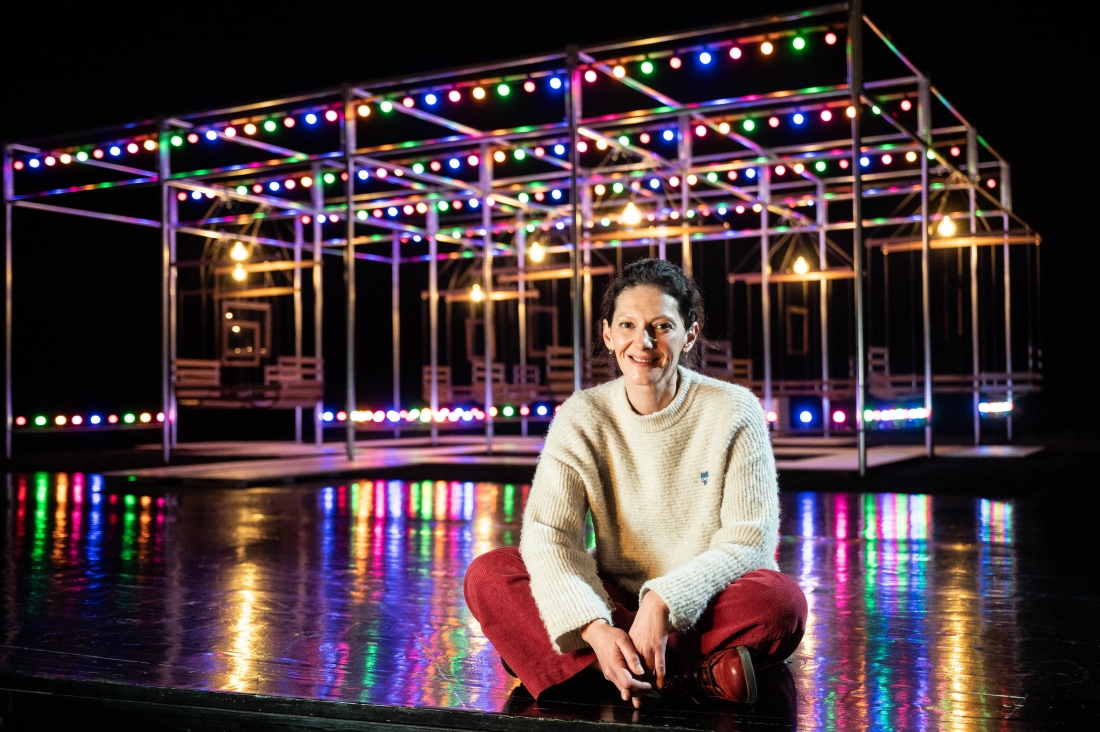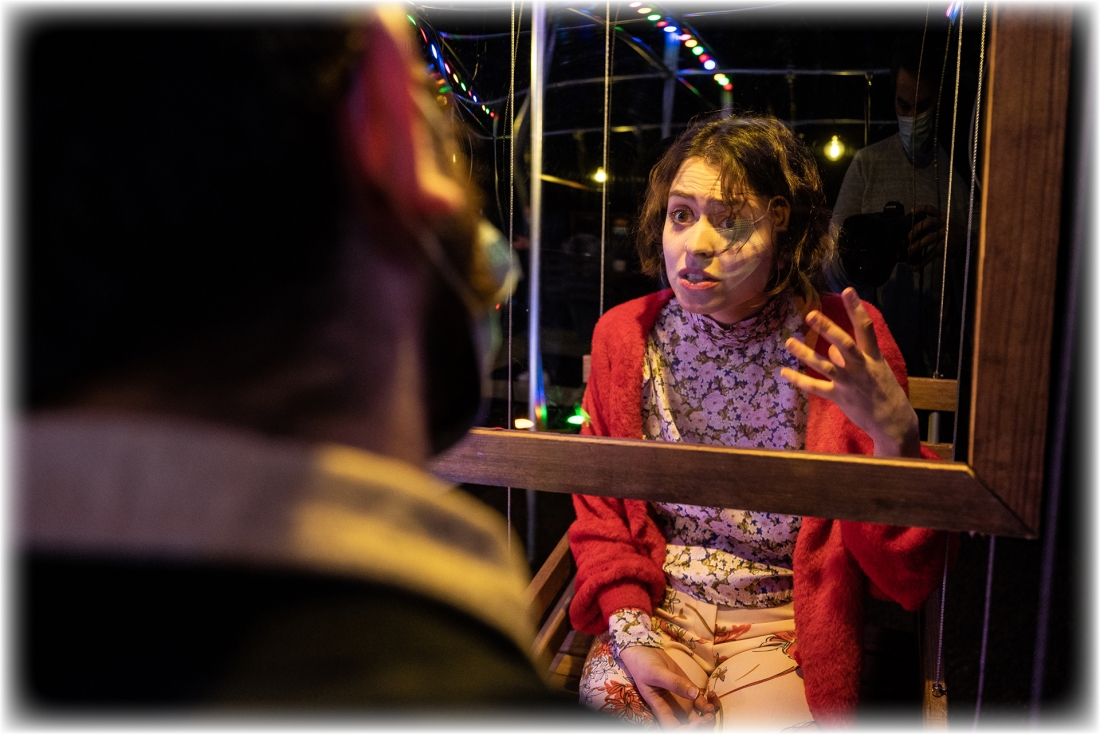Interview
Diana Sá
February
2022
Wed
9
Creator of Descanso na tua voz, on stage between February 10th and 12th at Teatro Rivoli
In this piece, the actors and spectators meet on the stage itself. Is it a self-referential representation, a representation of the theatre itself? What did you intend to represent?
In fact, I'm not sure if this is theatre. If I think in traditional theatre models, this does not belong to that language. It will belong to that family... It's a performance, a performative installation, something like that. But I'm not comfortable to say that I staged a show, or that this play is a theatre show. It came from an idea, from an impulse of mine related to all the issues we have been experiencing in recent years... To question how we – actors, creators, directors – are going to resolve some issues: how are we going to work with audiences, artistic objects, another way... Far be it from me to say that I'm creating something that has never been done, that's not what I'm saying... (laughs). The idea was to rethink the written text, the theatrical text, the word (which I like too). To think about how I could make a show with words and bring the audience closer, but in a way that they would not stay in their comfortable or uncomfortable position – given the circumstances of being in an audience surrounded by hundreds of people for several hours (and all the inherent issues). I wanted to create an object for the public to come and visit. A space created to receive not only spectators, but also actors and actresses. It is a place to meet and visit.
What does Descanso na tua voz [Rest in your voice] mean? To whom is it addressed?
I think it addresses everyone: who is doing the play and who is watching. In recent times – and not just because of the pandemic – there is a difficulty in listening... Listening in the sense of being a pleasure and not to obtain information that is important, a rule that has to be applied. I think this way of listening, without being relaxed, causes a false sense of control and stability. But, in fact, it will distance us all even more, we will be closed in our ideology, in our perspective and way of seeing the world. And everything I hear either serves to heighten that perspective or serves to counteract it. And there's no relaxation... I think it's really a matter of resting in the other's voice. Without being alert, questioning why they are telling me this, or having another rule to apply.
That's why the texts are like this: they promote a meeting between two people. The tone of interpretation is very personal. And the writer himself (Eduardo Brito) worked the texts in parallel with the rehearsals and gave the actors the opportunity to appropriate themselves, to change the words. Everything that facilitated this appropriation and offering of the experience.
Do you think it to be a wake-up call, or just a more relaxed listening exercise? Or both?
It's not a wake-up call, I don't have that kind of superiority or morals for it (laughs). It really is a space where, if people want to, they can experiment, simply listening to a text written and spoken by actors. If some people say, "I liked that one because it made me laugh", or "I liked that one because it's so tragic". It's an experience... It's just an experience, which I hope will be positive on a sensorial level – from someone who hears, from someone who sees, from someone who swings, how the movement of the other affects my body... Instead of being an intellectual exercise, again, of trying to get a moral or a conclusion from a story, or a position on something.
How do the set design, light and sound elements relate to the text?
What I propose are different experiences, at different levels, that don't have to feed each other. One thing is the visual part that people see... I wanted, together with Patrick Hubmann and Pedro Cavaco Leitão (scenographers), for there to be swings, a space limited by the structure itself. I wanted the lights to approach a fair, a popular festival. The sound (by João Guimarães) works more to cleanse the palate of the text. It was all thought out separately. There is no unity in the texts, except that they were written by the same author – who has his own style. What unifies the texts is the fact that people are sharing the same space.
I'm very curious about this experience... I'm not sure, and maybe I never will be sure, how it will work for each and every one. I'm looking forward to seeing how the next few days go.
In this piece, the actors and spectators meet on the stage itself. Is it a self-referential representation, a representation of the theatre itself? What did you intend to represent?
In fact, I'm not sure if this is theatre. If I think in traditional theatre models, this does not belong to that language. It will belong to that family... It's a performance, a performative installation, something like that. But I'm not comfortable to say that I staged a show, or that this play is a theatre show. It came from an idea, from an impulse of mine related to all the issues we have been experiencing in recent years... To question how we – actors, creators, directors – are going to resolve some issues: how are we going to work with audiences, artistic objects, another way... Far be it from me to say that I'm creating something that has never been done, that's not what I'm saying... (laughs). The idea was to rethink the written text, the theatrical text, the word (which I like too). To think about how I could make a show with words and bring the audience closer, but in a way that they would not stay in their comfortable or uncomfortable position – given the circumstances of being in an audience surrounded by hundreds of people for several hours (and all the inherent issues). I wanted to create an object for the public to come and visit. A space created to receive not only spectators, but also actors and actresses. It is a place to meet and visit.
What does Descanso na tua voz [Rest in your voice] mean? To whom is it addressed?
I think it addresses everyone: who is doing the play and who is watching. In recent times – and not just because of the pandemic – there is a difficulty in listening... Listening in the sense of being a pleasure and not to obtain information that is important, a rule that has to be applied. I think this way of listening, without being relaxed, causes a false sense of control and stability. But, in fact, it will distance us all even more, we will be closed in our ideology, in our perspective and way of seeing the world. And everything I hear either serves to heighten that perspective or serves to counteract it. And there's no relaxation... I think it's really a matter of resting in the other's voice. Without being alert, questioning why they are telling me this, or having another rule to apply.
That's why the texts are like this: they promote a meeting between two people. The tone of interpretation is very personal. And the writer himself (Eduardo Brito) worked the texts in parallel with the rehearsals and gave the actors the opportunity to appropriate themselves, to change the words. Everything that facilitated this appropriation and offering of the experience.
Do you think it to be a wake-up call, or just a more relaxed listening exercise? Or both?
It's not a wake-up call, I don't have that kind of superiority or morals for it (laughs). It really is a space where, if people want to, they can experiment, simply listening to a text written and spoken by actors. If some people say, "I liked that one because it made me laugh", or "I liked that one because it's so tragic". It's an experience... It's just an experience, which I hope will be positive on a sensorial level – from someone who hears, from someone who sees, from someone who swings, how the movement of the other affects my body... Instead of being an intellectual exercise, again, of trying to get a moral or a conclusion from a story, or a position on something.
How do the set design, light and sound elements relate to the text?
What I propose are different experiences, at different levels, that don't have to feed each other. One thing is the visual part that people see... I wanted, together with Patrick Hubmann and Pedro Cavaco Leitão (scenographers), for there to be swings, a space limited by the structure itself. I wanted the lights to approach a fair, a popular festival. The sound (by João Guimarães) works more to cleanse the palate of the text. It was all thought out separately. There is no unity in the texts, except that they were written by the same author – who has his own style. What unifies the texts is the fact that people are sharing the same space.
I'm very curious about this experience... I'm not sure, and maybe I never will be sure, how it will work for each and every one. I'm looking forward to seeing how the next few days go.




